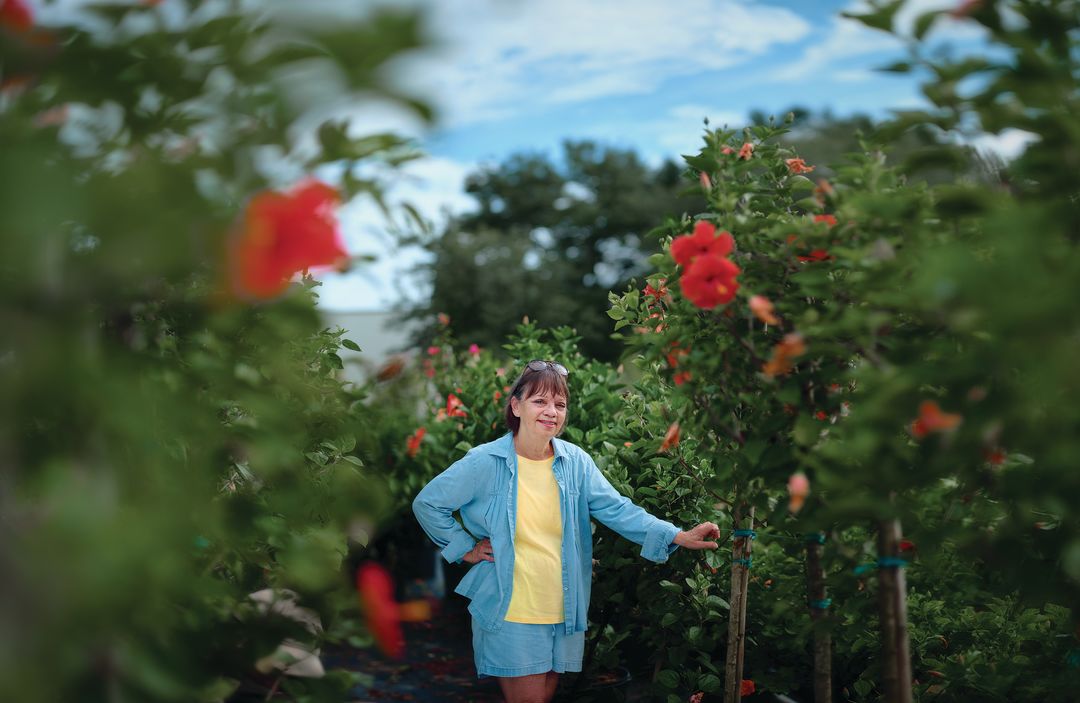New to Florida Gardening? Author and Gardener Chase Landre Can Help

Chase Landre at work at Barnett's Wholesale Nursery.
Image: Evan Sigmund
After trying her luck as a singer-songwriter in New York City (“I didn’t make it big but had a few songs recorded,” she says), Chase Landre moved to Bradenton in 1988 and found her new passion in the soil instead of the spotlight. She has authored several books on gardening, including Snowbird Gardening: A Guide for South Florida’s Winter Residents; operates the website south-florida-plant-guide.com; and spends her days helping desperate gardeners from the North cultivate a green thumb. Here she tells us some of the biggest mistakes gardeners new to Florida make.
Forgetting It’s Florida
“As a gardener, moving to Florida is like moving to a different planet. It’s subtropical here, with sandy soil. In the North and Midwest, you have snow, which adds nitrogen to the soil. We have very little nitrogen here. Those little tabs in the plants at the store might say ‘summer annual,’ but here it’s a winter annual. It might say ‘full sun,’ but in our full sun it will be dead in a week. Become a patron of a good local nursery and take the advice of people who have spent years working in this climate.”
Failing to See the Future
“A plant in a three-gallon container can grow to 25 feet, and quickly. When you buy a plant, you need to understand what it will look like as an adult. Snowbirds come back and have this behemoth they never imagined or plants way too close together fighting for space. Shrubs that grow too close fight for light and then get leggy at the bottom. People hate that, so they cut them way back and then they’re leggy all over again. Bigger shrubs should be planted about three feet apart from center; a smaller shrub, maybe two feet; and a little perennial like a blue daze, 1.5 feet from center.”
Starving Plants
“Most plants need soil amendments, but they don’t all want the same thing. For palms, add topsoil. For citrus, add cow manure. For a majority of plants, add a combination of both. But for drought-tolerant plants, topsoil retains water, and during our rainy season it gives those plants too much water. Eventually all these nutrients are going to be taken away by the plants, which means you need to fertilize; for most plants, this means three times a year. [Sarasota County prohibits the use of fertilizer containing nitrogen and phosphorus during the summer rainy season.] Any food is better than no food.”
Overwatering and Underwatering
“In the winter, give your yard and plants a good soak once a week or every 10 days. In the summer, water twice a week. A new planting needs watering at least three times a week. The best thing is to get an irrigation system. A lot of people think rainy season will take care of watering. But May can be one of our driest months, and it’s also getting hot. Plants are saying, ‘Where is my water?’”
Lack of Color
“Probably the biggest question I get is, ‘How can I get more color?’ Shrubs such as crotons, loropetalum and copper plants offer abundant, fiery color. You can also plant winter annuals such as geraniums, pansies and petunias for bursts of color. They look especially good at the entrance to a property.”
Misusing Mulch
“Don’t put mulch closer than six inches to a plant because mulch retains water. In rainy season, plants don’t dry out. I’ve also seen plants buried in so much mulch that they don’t grow. The best mulch is Grade A cypress bark. It’s more expensive but lasts far longer. It helps repel mosquitoes and termites. And it can be fluffed up so that it still looks good after many months.”
Mismanaging the Cold
“Protect your plants by watering them early in the day if a cold snap is expected in the night. That helps the plant absorb warmth in the air from that water during the day and helps keep the root ball warm. Covering plants in a sheet to protect them from the cold does not work. It’s like standing out there naked in a sheet. You need a frost cloth, sold at most nurseries, which will keep the moisture off the plant.”
Landre’s Four Basics
1. Plant no deeper than the plant was in its original container. Use soil amendments (such as composted cow manure) when planting to give your plants a head start. Don’t pile mulch around plants.
2. Don’t plant more than you can care for and don’t space plants too close together.
3. Consult your nursery to pick the best plants for the amount of sun, water and cold weather.
4. Accept that you’ll lose a plant. Get a new one and try again.


